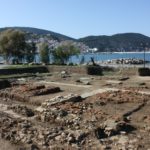Asklepeion
Skopelos Asklepeion, Skopelos Archeological Sites, Skopelos Sightseeings, Asklepion Skopelos, Skopelos Asklepieion, The asklipion of Skopelos
ASKLEPEION, Ampeliki, Skopelos 4th century BC
SKOPELOS ARCHEOLOGICAL SITES
The Asklepion of Skopelos is located southeast of Skopelos Gulf, in the area of Ambeliki, Livadi.
All tourists have been to this wonderful archaeological site at the beachfront of Skopelos Chora. But what is the Asklipion of Skopelos really? It used to be a healing centre during ancient Greece times, and especially in the 5th-4th century BCE. As all the healing centres it was dedicated to Asklepios.
But who was Asklepios? Well, he was a demigod in ancient times and the leader of a cult. In a world of slavery, where human life was worthless, this cult raised the level of humanity for the benefit of the individual. So, Asklepios, the healer of all sickness, was an exception in the Greek pantheon. People were usually afraid of the representatives of the Greek pantheon.
Over a period of 1000 years, people on an international scale loved and believed in Asklepios. Epidauros used to be the centre of his belief, while there were over 300 sanctuaries in the Mediterranean region.
The origin of the name Asklepios comes either from the ancient Greek word “Asklepas” (a name for a snake) or from the surname of his mother, Aigia. According to the myth, Asklepios had several children, including a daughter, “Hygieia”. From that daughter, the English word “hygiene” derives.
Because of Asklepios, more individuals remained healthy. But the underworld wanted more dead people. So the underworld killed Askpeleos. Later, he was brought back to life and transformed into a god. Zeus placed the image of Asklepios, with his snake, among the stars. This temple site of Asklepeion was first excavated in 1965 when a treasure of ancient coins from the classical to the end of the Roman period was found. Moreover, a statue of Diana (3rd century BC) and a marble torso of a child holding a stick were found. Further excavations made in 1995 brought to light walls and pottery.

